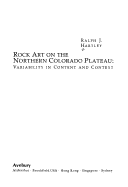The author considers aboriginal rock art to be one source of information used by prehistoric peoples in constructing knowledge about the dynamics of the social and physical environment in which they lived. This study examines the relationships between the morphological content of petroglyphs and pictographs and the places at which they occur along the drainage system of the Colorado River in southeastern Utah. Hartley examines the assemblage content of rock art at 388 locations to assess their variation with situational features noted at these places. He argues that rock art situated on boulders and at the bases of cliffs...Read more
The author considers aboriginal rock art to be one source of information used by prehistoric peoples in constructing knowledge about the dynamics of the social and physical environment in which they lived. This study examines the relationships between the morphological content of petroglyphs and pictographs and the places at which they occur along the drainage system of the Colorado River in southeastern Utah. Hartley examines the assemblage content of rock art at 388 locations to assess their variation with situational features noted at these places. He argues that rock art situated on boulders and at the bases of cliffs reveals the greatest information while displays of access restriction are considered more prevalent in rockshelters. Hartley concludes that the frequency and diversity of use of places exhibiting rock art is reflected in the information content of the rock art and that rock art varies with the kinds of functions these places served in the socioeconomic system of aboriginal peoples.
- ISBN10 1856287009
- ISBN13 9781856287005
- Publish Date 26 March 1992
- Publish Status Out of Print
- Out of Print 26 March 2009
- Publish Country GB
- Publisher Taylor & Francis Ltd
- Imprint Avebury
- Format Hardcover
- Pages 168
- Language English
